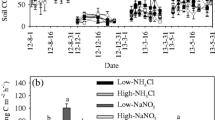Abstract.
An experiment was conducted in an Andosol paddy field in Shizukuishi (Iwate Prefecture, Japan) to determine the effects of free-air CO2 enrichment (FACE) on biological N2-fixation activity and soil microbial biomass C at three levels of N application. Rice (Oryza sativa L. cv. Akitakomachi) plants were grown under ambient CO2 or FACE (ambient +200 µmol mol–1 CO2) conditions throughout the growing season with each treatment having four replicated plots. Three levels of N fertilizer (high, standard and low; 15, 9 and 4 g N m–2, respectively) were applied to examine the effect of different N availability under both CO2 conditions. Soil samples were collected at four different times from upper and lower soil layers (0–1-cm and 1–10-cm soil depths, respectively) and analysed for biological N2-fixation (BNF) activity and microbial biomass C (MBC) by the acetylene reduction and chloroform fumigation-extraction methods, respectively. The amounts of chlorophyll-type compounds (Chls), an index of algal growth, and soil available C were also determined. Compared to the ambient CO2 treatment, the FACE treatment had significantly higher BNF activity in both the upper and lower soil layers at ripening only in low-N soil and at harvest at all three levels of N fertilization rates. MBC was significantly increased by FACE in both the upper and lower soil layers from the middle to later period of the growing season compared to the ambient CO2 treatment. The FACE treatment increased the Chls in the upper soil layers at ripening only in low-N soil and at harvest at all three levels of N fertilization rates. The amount of soil available C was not significantly different between FACE and ambient CO2 treatments in both the upper and lower soil layers throughout the cropping season. From these results it can be concluded that the FACE treatment had a significantly positive influence on BNF activity, MBC and Chls at different levels of N fertilization rates in paddy field during the cropping season.
Similar content being viewed by others
Author information
Authors and Affiliations
Additional information
Electronic Publication
Rights and permissions
About this article
Cite this article
Hoque, M.M., Inubushi, K., Miura, S. et al. Biological dinitrogen fixation and soil microbial biomass carbon as influenced by free-air carbon dioxide enrichment (FACE) at three levels of nitrogen fertilization in a paddy field. Biol Fertil Soils 34, 453–459 (2001). https://doi.org/10.1007/s00374-001-0430-8
Received:
Issue Date:
DOI: https://doi.org/10.1007/s00374-001-0430-8




